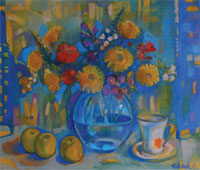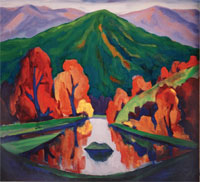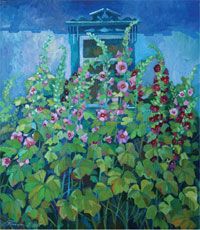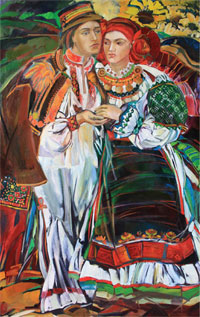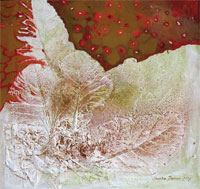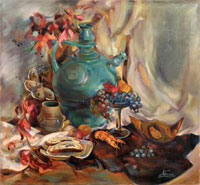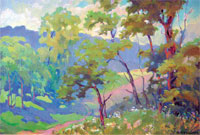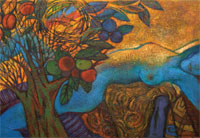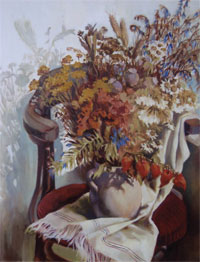 |
Oksana Havrosh, Uzhhorod. |
You cannot imagine the art of Transcarpathia of the present day without the work of women artists. Due to the modern tendencies in the Ukrainian art of the 20th century the problems of gender became actual, and the dismissed by time patriarchal dogmata concerning the distribution of roles in art were ruined. A woman ceased to be only the object seen from outside. She creates bravely, changing the __ and education, profession, convictions become the decisive factor. The sound of women and men voices in the cacophony of the Modern Ukrainian art space is far from being equal. Gradually the art is getting rid of the unified monophony. And Transcarpathian is not an exception.
The peculiarities of the forming of the Transcarpathian school of art showed in the interpenetration of traditional and modern art. In the end of the 20th century new authors appear in the artistic circles of Transcarpathia and they are women-artists. They bring in new themes, new types of heroes, they turn to women psychology and put an accent on women values.
Their works are concentrated mostly on personal collisions, on the intimate and not the public. The work of Lesya Priymych may serve as a good example in this context. In spite of the outer monumentalism of the form the author succeeds in creating the intimate characters thrilling by their charm and nobleness. Her symbolic and allegoric compositions return us to the roots of folk art. Tending to metaphoric and philosophical generalization make her canvases sound epic. On the symbolic level Lesya Priymych manages to discrown the myth about the non-sacral character of the modern painting and to give the specific sound in presenting the archaic Ukrainian symbols.
The essence of a woman is to admire the native scenery or the world of things and it is naturally depicted in the works of many women artists. The landscape paintings of Tetyana Levlyas, Tetyana Sopilnyak and Emma Levadska are singled out because of their ”uncommon view” on common everydayness. These works are full of sincerity, purity and sentimentality, they feature the thorough choice of figurative means, the harmony of motifs and colour solutions.
The creative feature that marks the works of Mariya Mytryk and Olha Skakandiy is the flow of mood in treating the images. Subdued colours, a ballanced composition, moderate emotions transalte the rich inner world of the artists.
The creative method of Lyubov Mykyta is to present the beauty of the native land using the expressive manner – the sonorous confrontations of pure colours in her vast compositions. The nature of the native land, its people and archetypes, that make the basis of the culture of the Ukrainian people, are the source of her inspiration.
The works of Odarka Dolhosh are perceived as not read letters with codified messages. Things and landscapes, common at first glance lead a spectator into misterious action – into the ritual of coming back to your own soul. You can watch how micro and macro elements are being born from the fretwork of the lines, they are put together like puzzles, trying to answer the question – who are you.
Priority of decorativeness and positive energetic field – this is the creative credo of Nadiya Didyk. Her compositions are amazing for their dynamics and for unexpected illusions of space. The artist tries to discover the optimal balance of the associative and figurative elements and colour surfaces, in the search for the new forms of her own emotions.
Olena Kondratyuk is the artist who doesn't depict but rather reflects. An intense monologue is felt in her works. The mixed hues of her palette serve the expression of the colours, where every colour is the codified element of the inner state. Her heroes are the strangers who in patriarchal society with distributed limits and norms are accepted as the watchers from outside.
It won't be an exaggeration to assert that the creative work of women artists in Transcarpathian art has considerably precipitated the development of psychological component in painting. It is a new experience, it is a way from wide strokes, from epic things to the psychological fluency, to the presentation of the world in an undertone, in a half-tint…
Oksana Havrosh,
art historian.
Uzhhorod.






